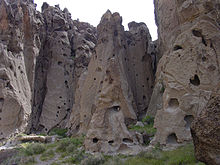| Mojave National Preserve | |
|---|---|
IUCN category V (protected landscape/seascape) | |
 Joshua trees along Cima Road in the Mojave National Preserve | |
| Location | San Bernardino County, California, US |
| Nearest city | Baker, California |
| Coordinates | 34°53′N 115°43′W / 34.883°N 115.717°W |
| Area | 1,542,776 acres (6,243.39 km2)[1] |
| Created | October 31, 1994 |
| Visitors | 866,635 (in 2021) |
| Governing body | National Park Service |
| Website | nps |
| External videos | |
|---|---|
 | |
Mojave National Preserve is a United States National Preserve located in the Mojave Desert of San Bernardino County, California, US, between Interstate 15 and Interstate 40. The preserve was established October 31, 1994, with the enactment of the California Desert Protection Act by the United States Congress,[2] which also established Joshua Tree National Park and Death Valley National Park as National Parks. Previously, some lands contained within the Preserve were the East Mojave National Scenic Area, under the jurisdiction of the Bureau of Land Management.[3] At 1,542,776 acres (6,243 km2), within the contiguous United States it is the third largest unit of the National Park System and the first largest National Preserve. The preserve was created within the Pacific West Region of the National Park Service and remains within that jurisdiction today.
Natural features include the Kelso Dunes, the Marl Mountains and the Cima Dome, as well as volcanic formations such as Hole-in-the-Wall and the Cinder Cone Lava Beds. The preserve surrounds Providence Mountains State Recreation Area and Mitchell Caverns Natural Preserve, which are both managed by the California Department of Parks and Recreation.
Impressive Joshua tree forests are found in parts of the preserve. The forest covering Cima Dome and the adjacent Shadow Valley is the largest and densest in the world.[4] In August 2020, a wildfire destroyed 1.3 million Joshua Trees around Cima Dome.[5] The ghost town of Kelso is found in the preserve, with the defunct railroad depot serving as the Visitor Center. The preserve is commonly traversed by 4 wheel drive vehicles traveling on the historic Mojave Road.
Climate in the preserve varies greatly. Summer temperatures average 90 °F (32 °C), with highs exceeding 105 °F (41 °C). Elevations in the preserve range from 7,929 feet (2,417 m) at Clark Mountain to 880 feet (270 m) near Baker. Annual precipitation varies from 3.37 inches (86 mm) near Baker, to almost 9 inches (230 mm) in the mountains. At least 25% of precipitation comes from summer thunderstorms. Snow is often found in the mountains during the winter.



